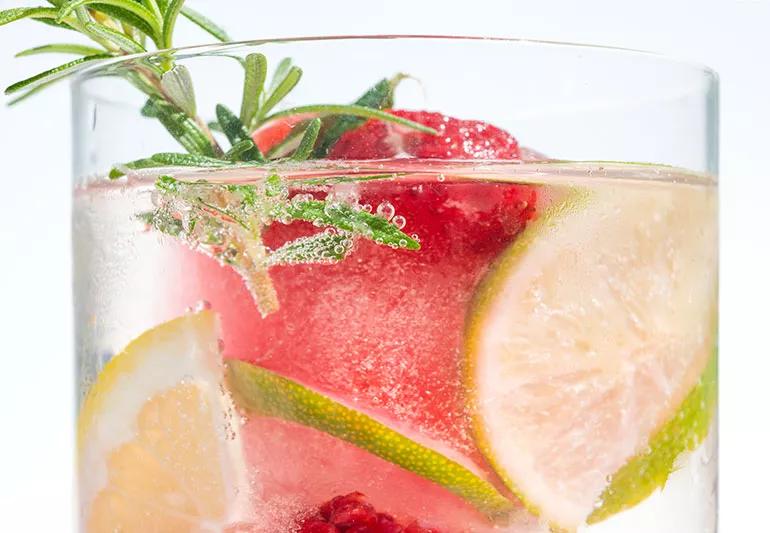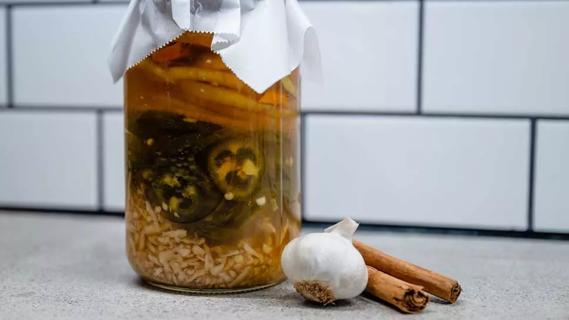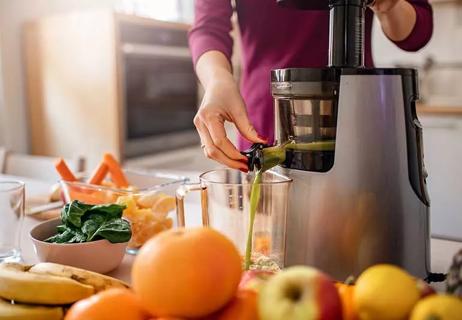From infused water to fresh juices, you'll savor every sip

There’s nothing like kicking back in a comfortable deck chair and soaking up the sun with an ice-cold drink in your hand.
Advertisement
Cleveland Clinic is a non-profit academic medical center. Advertising on our site helps support our mission. We do not endorse non-Cleveland Clinic products or services. Policy
Yes, we said “drink.”
Hey, it’s 5 o’clock somewhere after all. We can’t blame you if you’re thinking about a martini, frosty daiquiri, margarita — or maybe a good, stiff classic cocktail to hit the spot. But the drinks we have in mind aren’t the ones that get you buzzed. They’re the ones that can help you bounce back during those sweltering summer days. We’re talking about infused water and fresh juices that offer numerous health benefits and help lighten up some of our favorite libations.
Some of us love water. We can drink it from the tap, cooler or even out of a box or can. If you hate drinking water, you probably checked out at “some of us love water.” That’s OK. You might not like it, but you know you need to drink it. We have some tips to help you make those eight glasses a day much easier to tolerate.
Water does so much for the body. Your body needs it to help regulate your temperature, eliminate waste and to lubricate and protect the joints, spinal cord and delicate tissues. It’s recommended that you drink 64 ounces of water daily, but you may need more depending on your weight, activity level, diet and the climate you live in.
“If you’re outside a lot or exercising outdoors, you’re sweating more. So, yes. That would definitely require more water,” says registered dietitian Kate Patton, MEd, RD, CSSD, LD. “But if you’re the type that doesn’t like the heat and you prefer to stay inside in the air conditioning, you really wouldn’t need to increase the amount of water you drink.”Patton suggests drinking at least the recommended amount and adjusting accordingly.
Advertisement
If you’re not sure that you’re getting enough water, your urine is a good indicator. If it’s dark yellow and smells strong, drink more water. Keep in mind that it should be light yellow like lemon juice or almost clear. It also shouldn’t have a strong odor.
“I think it’s a good idea to add some natural flavors rather than artificial. It’s just a good way to flavor water without having to worry about artificial sweeteners, real sugar or dyes,” says Patton. It’s OK to throw fruit, herbs or even vegetables that you like into water, but you might want to try a combination of ingredients to give it a boost of vitamins, minerals and antioxidants. But of course, Patton says you’ll only get these essentials if you eat what you toss into your water.
Here’s some inspiration for infusing your water.
Strawberries are packed with antioxidants, especially vitamin C. They’re also a good source of fiber and manganese. Basil has antioxidant properties and is a good source of manganese and vitamins A and K. To bring out the flavors of both ingredients, you can muddle them and add the mixture to still or flavored sparkling water.
Lemons are packed with vitamin C, potassium and vitamin B6. Vitamin C is wonderful for skin health and immunity. Potassium can help lower blood pressure and improve heart health, and vitamin B6 helps to turn food sources into energy. Ginger offers antioxidant compounds and is good for digestive issues and nausea. For maximum flavor, you can also muddle these ingredients and add them to your water.
The longer you allow fruits, veggies or herbs to remain your water, the bolder the flavor will be. Try infusing your water for a minimum of two hours. If you can wait, you can even allow the flavors to come together by letting the infusion sit in the refrigerator overnight.
You can infuse your water for a couple of hours at room temperature if you want to drink it much sooner. For longer infusion periods, it’s best to chill your water in the fridge to prevent bacteria growth. If you plan to serve pitchers of infused water at a gathering, be sure to keep them cold.
Summer means a bounty of fresh fruits and vegetables. If you’ve been considering juicing, now is a great time to do it. Juicing allows you to get more concentrated amounts of vitamins and minerals. It also provide us with a way to absorb nutrients easier. Patton explains.
“Some nutrients are absorbed a little better in liquid form. One of them is lycopene. Tomatoes are a major source of lycopene, so fresh tomato juice would be good compared to canned tomato juice. You can also get lycopene from watermelon and grapefruit, so try juicing them and then adding the juice to water to give it more flavor.”
While juicing offers some great positives, there are some things that you’ll need to watch out for once you hop on the juice train.
Advertisement
For one, concentrated amounts of vitamins, minerals and nutrients also mean concentrated amounts of natural sugar, especially when it comes to fruit juice. Sure, natural sugars are better than refined sugars or artificial sweeteners, but in large amounts, they can cause problems for people who are watching their weight or people who have diabetes.
“My one concern with juicing is that it concentrates the calories so much. And if you’re juicing fruit, you end up getting a lot of fructose at one time. That concentrated amount could spike your blood sugar pretty fast. If you’re an average healthy person, it’s not a big deal. But if you’re concerned about your blood sugar levels or concerned about your weight, some fresh juices can be concentrated sources of sugar and calories. Be careful with that,” says Patton.
To give fresh juices a healthier twist, Patton recommends leaving the pulp in (sorry pulp-free peeps). The pulp is a good source of fiber and since fiber takes longer to digest, you won’t experience those major blood sugar spikes. You can also try making fruit and vegetable juice blends so you’re not getting as much sugar. Try tossing in cucumbers, tomatoes, spinach, kale, wheatgrass or other veggies that you love. And if you like a little heat, you can add ginger, jalapenos or horseradish root if you’re brave!
Advertisement
Patton says that another way to avoid blood sugar spikes is by practicing portion control with the juice you make. You can dilute it by adding it to water, tea or the cold beverage of your choice. Get creative. We won’t judge!
Summer may be a lot different this year, but you can still keep it cool, fun and refreshing.
For an icy treat, you can use your juice (pulp included) or pureed fruit to make delicious smoothies. Here’s an easy way to do so.
Puree 1-1½ cups chopped watermelon, mango, kiwi or strawberries with 1 cup of ice and a little water or fresh juice. All three fruits have a lot of water in them and are good sources of folic acid, vitamin A and fiber. Pour your smoothie in a nice frosted glass and sip away while you’re sitting on the deck or relaxing in your hammock.
With fresh juices and infused water, the options are endless. So cheers to tastier summer sips!
Advertisement
Learn more about our editorial process.
Advertisement

Options for sober social drinking are abundant, but be mindful about additives and triggers

Pickle juice has a reputation as a probiotic powerhouse, workout recovery aid, hangover cure and more

If you’re looking to boost your gut health, it’s better to get fiber from whole foods

While it isn’t bad for you, celery juice isn’t the detox phenom it’s claimed to be

Regularly drinking these sugar-fueled, stimulant-laden beverages can increase your risk of adverse health effects

This spicy concoction can do more harm than good, upsetting your stomach and causing painful acid reflux

Juicing removes beneficial fiber from fruits and veggies and raises your blood sugar

Sports drinks can give your body a boost, but it’s important not to overuse them

Start having sex about 72 hours before ovulation, then at least every other day during your fertile window

Attachment theory suggests that your earliest relationships shape connections throughout your life

It isn’t a recognized mental health disorder, but research shows that problematic social media use can negatively affect your mental health, self-esteem and sleep